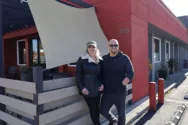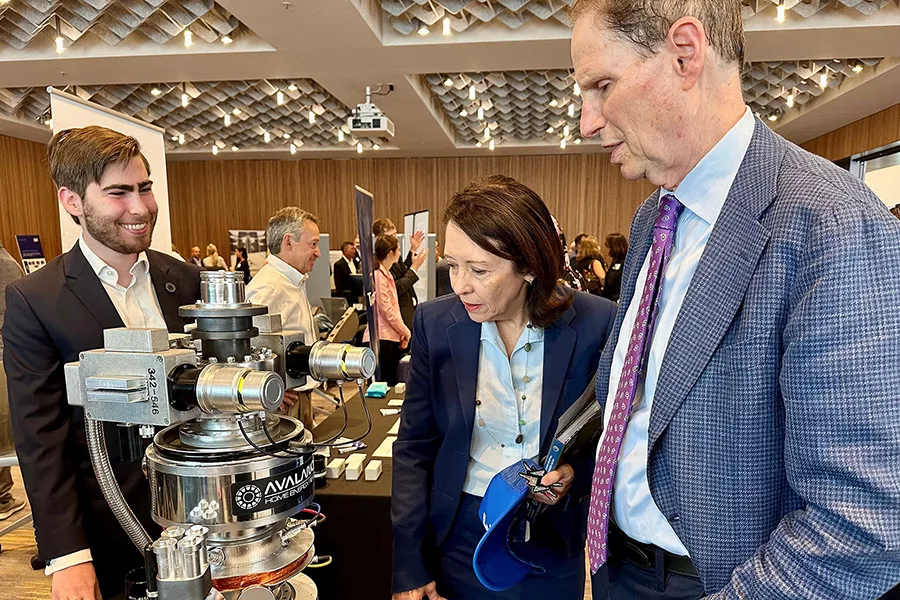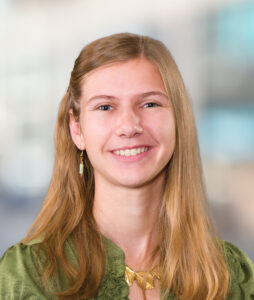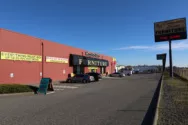
Home » Seattle-area company set to launch fusion test facility in north Richland
Energy
Seattle-area company set to launch fusion test facility in north Richland

Avalanche Energy’s Richland facility will be a testing space for the company’s fusion technology as it works to scale up the machines. U.S. Sens. Maria Cantwell, D-Washington, center, and Ron Wyden, D-Oregon, right, view a replica of Avalanche’s fusion machine at the Pacific Northwest Energy Summit in July of 2024.
Courtesy Avalanche EnergyApril 14, 2025
A Seattle-area fusion company recently received the keys to a warehouse in Richland, and is moving forward with big plans for the space.
Avalanche Energy, which launched in 2018, hopes to start construction on its Richland fusion test facility, to be called FusionWERX, this summer.
It has officially moved into a more than 20,000-square-foot Port of Benton-owned space at 2345 Stevens Drive. The building was once home to Kurion, now a part of Veolia, which built a detritiation facility licensed for tritium operations.
That facility was one reason Avalanche was drawn to Richland since the company will also be working with tritium.
The company said it is excited to be working with Fusion Fuel Cycles, a joint venture between Kyoto Fusioneering and Canadian Nuclear Laboratories, with which it recently signed a memorandum of understanding. Avalanche also hopes to partner with other organizations on the lab space.
“We are excited that Avalanche Energy has selected our community to launch its groundbreaking fusion test facility, helping advance our state’s energy goals,” said Diahann Howard, Port of Benton’s executive director, in a statement.

A nuclear fusion company is coming to Richland with big plans for a testing facility and new partnerships. Avalanche Energy will be setting up shop in Port of Benton-owned 2345 Stevens Drive, with construction to start this summer.
| Courtesy Avalanche EnergyScaling up
Avalanche works on small fusion reactors, which allows the company to quickly test new ideas, often on a weekly basis, and spend less money than on a larger model.
“I like to say we’re trying to build the world’s smallest, most compact high performance fusion reactors,” said Robin Langtry, Avalanche’s CEO.
He anticipates using the technology to power satellites or unmanned submersibles. The company has a contract with the U.S. Department of Defense. Later, Langtry hopes that the technology could power data centers or cargo shipping.
Avalanche first achieved successful fusion in 2022, and now the company is focused on scaling up. That’s what the Richland test facility will be used for.
The current machines are 12 centimeters in diameter, Langtry said, and they produce a very small amount of energy. As the prototypes expand to a meter-and-a-half in diameter, they will generate hundreds of watts of energy, and then they will eventually scale to kilowatts and megawatts.
“The idea is that this is almost like a wind tunnel for fusion technology development,” Langtry said of the facility.
Avalanche hopes FusionWERX can be up and running and fully licensed by the end of 2026 or beginning of 2027, Langtry said.
The facility is privately funded, Langtry said, but the company expects to have a mix of private and public funding going forward.
The company currently has offices in Tukwila with about 50 employees. Langtry said that once FusionWERX launches, it could have 15 staff running it. But with Avalanche’s FFC partnership, that could be more like 50 to 70 people.
“If we start getting into component qualification, materials testing and development, I could see that becoming hundreds of folks associated with this facility at some point,” he said.
Avalanche is looking at this as a long-term investment. “We’re planning to be there for a while, operating this facility,” Langtry said.
When it comes to workforce, he anticipates some Seattle staff traveling back and forth between the facilities, but the company also will hire locally, drawing on the expertise already present in the Tri-Cities.

Seattle-based Avalanche Energy got its start in 2018 and works with small fusion machines. The size of the models allow the company to keep costs down and quickly try out new ideas.
| Courtesy Avalanche EnergyPartnerships
FusionWERX won’t just be a testing facility for Avalanche, though. Inspired by other technology startups opening their testing facilities to other users, Avalanche hopes to follow a similar model with its space in Richland.
The partnership with FFC might include collaborating in the FusionWERX space. FFC works on developing tritium breeding blankets, a tool that could perpetuate fuel for the fusion machines.
The breeding blankets would surround the machines and capture the neutrons released in the fusion process and breed tritium, the fuel the machines run on, Langtry said. The tritium is then reinjected into the machines.
FFC might use the facility to test its technology on actual fusion machines.
The company also is talking with Washington State University Tri-Cities and the Pacific Northwest National Laboratory about potential partnerships.
“We’re really excited to add to the list of partners in this facility along with FFC,” Langtry said.
Tri-Cities organizations are excited to have Avalanche in town, too.
“Just as the United States chose the Tri-Cities to build the first fission reactor in 1943, we are overjoyed that Avalanche Energy will build the first-of-a-kind FusionWERX commercial-scale testbed in our region,” said Karl Dye, president and CEO of the Tri-Cities Development Council, in a statement. “Our entire community stands ready to support Avalanche Energy in their vision to create the fusion energy supply, right here in the Tri-Cities.”
Real Estate & Construction Local News Energy Manufacturing
KEYWORDS April 2025
Related Articles
Related Products





